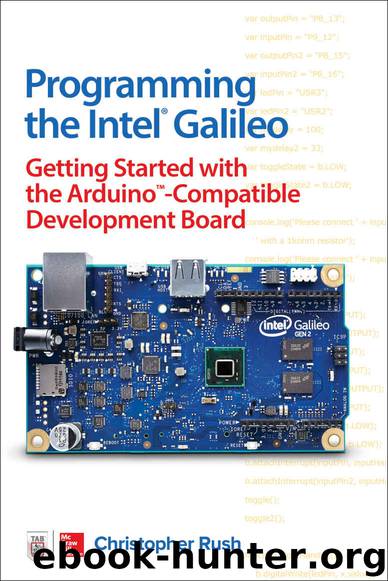Programming the Intel Galileo: Getting Started with the Arduino -Compatible Development Board by Rush Christopher

Author:Rush, Christopher [Rush, Christopher]
Language: eng
Format: epub, azw3
Publisher: McGraw-Hill Education
Published: 2016-11-29T05:00:00+00:00
Analog Inputs
As you have learned with digital inputs, the information you receive from a digital device is either HIGH or LOW, ON or OFF. In contrast, there are a number of devices that can have a range of values, such as dials, sliders, temperature sensors, and many more. Analog inputs on the Galileo board give us a value ranging from 0 to 4095 up to 5 V. Just like other Arduino boards, the Intel Galileo has six 12-bit analog pins that you can use to read analog devices (see Figure 5.4 ).
Figure 5.4 Intel Galileo board analog pins .
The analog pins on the Galileo will accept any voltage between 0 and 5 V. As previously mentioned, because we are using a digital system, these values must be converted into digital using an analog-to-digital converter (ADC), which is featured on the Galileo board.
Luckily for us, we do not have to understand how the ADC works in too much detail because the software we will write will take care of most of it for us.
Download
Programming the Intel Galileo: Getting Started with the Arduino -Compatible Development Board by Rush Christopher.azw3
This site does not store any files on its server. We only index and link to content provided by other sites. Please contact the content providers to delete copyright contents if any and email us, we'll remove relevant links or contents immediately.
Building Low Latency Applications with C++ by Sourav Ghosh(2810)
Fusion 360 for Makers by Lydia Sloan Cline(1981)
Networking A Beginner's Guide by Bruce Hallberg(1932)
But How Do It Know? by J. Clark Scott(1813)
Computers For Seniors For Dummies by Nancy C. Muir(1769)
Arduino Project Handbook, Volume 2: 25 Simple Electronics Projects for Beginners by Geddes Mark(1754)
Hands-On Linux for Architects by Denis Salamanca(1722)
Hack and HHVM by Owen Yamauchi(1670)
31 Days Before Your CompTIA A+ Exams (Shanette Luellen's Library) by Benjamin Patrick Conry(1659)
PrestaShop Recipes by Arnaldo Pérez Castaño(1465)
MicroPython Projects by Jacob Beningo(1454)
Hands-On Internet of Things with MQTT by Tim Pulver(1407)
9781803246888-ENHANCING DEEP LEARNING WITH BAYESIAN INFERENCE by Unknown(1404)
Raspberry Pi Electronics Projects for the Evil Genius (Tab) by Norris Donald & Norris Donald(1381)
Getting Started with Soldering: A Hands-On Guide to Making Electrical and Mechanical Connections by Vinck Marc de(1378)
Embedded Systems Architecture by Daniele Lacamera(1376)
Healthcare Information Security and Privacy (All-In-One) by Sean Murphy(1368)
Shaping the Fourth Industrial Revolution by Klaus Schwab & Nicholas Davis & Satya Nadella(1357)
The Internet of Things (The MIT Press Essential Knowledge series) by Greengard Samuel(1345)
